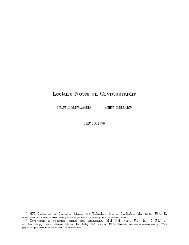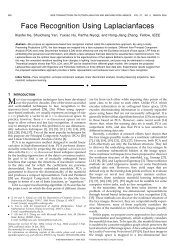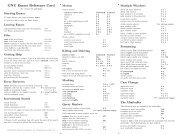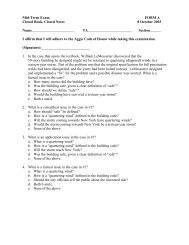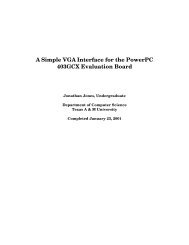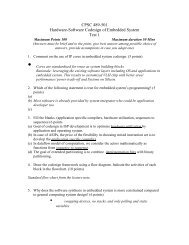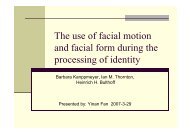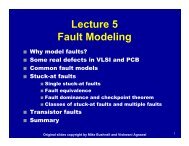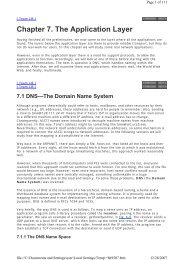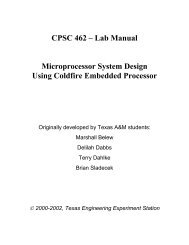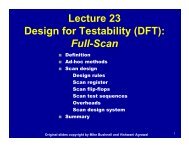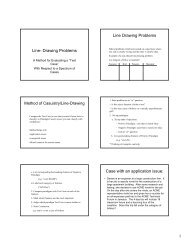This is a set of examples of page replacement problems. Please ...
This is a set of examples of page replacement problems. Please ...
This is a set of examples of page replacement problems. Please ...
You also want an ePaper? Increase the reach of your titles
YUMPU automatically turns print PDFs into web optimized ePapers that Google loves.
<strong>Th<strong>is</strong></strong> <strong>is</strong> a <strong>set</strong> <strong>of</strong> <strong>examples</strong> <strong>of</strong> <strong>page</strong> <strong>replacement</strong> <strong>problems</strong>. <strong>Please</strong> keep a few things in mind:<br />
these are small <strong>problems</strong> and will not necessarily reflect all character<strong>is</strong>tics <strong>of</strong> the real world<br />
I have endeavored to be correct but errors are possible<br />
The presentation <strong>is</strong> based upon a typical test problem. <strong>Th<strong>is</strong></strong> <strong>is</strong> followed by a solution that we believe would lead to<br />
full credit. Of course, th<strong>is</strong> solution was worked by hand and then converted to LATEX which guarantees a nice<br />
presentation but not necessarily a correct mapping.<br />
1. Consider the reference string shown along the top <strong>of</strong> the following graphical structure. The system has four<br />
frames. Use the LRU algorithm to select <strong>page</strong>s for <strong>replacement</strong>. Place the <strong>page</strong> number in the proper frame.<br />
Mark when <strong>page</strong> faults occur in the bottom line <strong>of</strong> boxes. State how many <strong>page</strong> faults occur. The numbers<br />
across the top indicate the reference string.<br />
Frame 0<br />
1<br />
2<br />
3<br />
Fault ?<br />
0 1 3 6 2 4 5 2 5 0 3 1 2 5 4 1 0<br />
0 1 3 6 2 4 5 2 5 0 3 1 2 5 4 1 0<br />
Frame 0 0 0 0 0 2 2 2 2 2 2 2 1 1 1 1 1 1<br />
1 1 1 1 1 4 4 4 4 4 3 3 3 3 4 4 4<br />
2 3 3 3 3 5 5 5 5 5 5 2 2 2 2 0<br />
3 6 6 6 6 6 6 0 0 0 0 5 5 5 5<br />
Fault ? * * * * * * * * * * * * * *<br />
In the example above the faults are marked with an * There were fourteen <strong>page</strong> faults.<br />
1
2. Clock algorithm. The second chance algorithm <strong>is</strong> an approximation <strong>of</strong> LRU based on using one use bit for<br />
each <strong>page</strong>. When a <strong>page</strong> <strong>is</strong> used its use bit <strong>is</strong> <strong>set</strong> to 1. We also use a pointer to the next victim which <strong>is</strong><br />
initialized to the first <strong>page</strong>/frame. When a <strong>page</strong> <strong>is</strong> loaded, it <strong>is</strong> <strong>set</strong> to point to the next frame. The l<strong>is</strong>t <strong>of</strong> <strong>page</strong>s<br />
<strong>is</strong> considered as a circular queue. When a <strong>page</strong> <strong>is</strong> considered for <strong>replacement</strong>, if the use bit for the next victim<br />
<strong>page</strong> <strong>is</strong> examined. If it <strong>is</strong> zero [that <strong>page</strong> <strong>is</strong> replaced] otherw<strong>is</strong>e [the use bit <strong>is</strong> <strong>set</strong> to zero, the next victim<br />
pointer <strong>is</strong> advanced, and the process repeated until a <strong>page</strong> <strong>is</strong> found with a zero use bit].<br />
Frame 0<br />
1<br />
2<br />
3<br />
Fault ?<br />
Consider the reference string shown along the top <strong>of</strong> the following graphical structure. The system has four<br />
frames. Use the clock algorithm described in the previous paragraph. The narrow boxes to the right <strong>of</strong> the<br />
<strong>page</strong> number boxes can be used to keep up with use bits. Use the space between the <strong>page</strong> number boxes to<br />
show the next victim pointer. The initial one <strong>is</strong> shown, Place the <strong>page</strong> number in the proper frame. Mark<br />
when <strong>page</strong> faults occur in the bottom line <strong>of</strong> boxes. State how many <strong>page</strong> faults occur.<br />
0 1 3 6 2 4 5 2 5 0 3 1 2 5 4 1 0<br />
0 1 3 6 2 4 5 2 5 0 3 1 2 5 4 1 0<br />
Frame 0 0 0 0 0 2 2 2 2 2 2 3 3 3 3 4 4 4<br />
1 1 1 1 1 4 4 4 4 4 4 1 1 1 1 1 1<br />
2 3 3 3 3 5 5 5 5 5 5 2 2 2 2 0<br />
3 6 6 6 6 6 6 0 0 0 0 5 5 5 5<br />
Fault ? 1 1 1 1 5 1 1 1 5 1 1 1 5 2<br />
Fourteen <strong>page</strong> faults.<br />
The number in a box indicates the <strong>page</strong> number in that frame after th<strong>is</strong> operation<br />
indicates the <strong>page</strong> has been used<br />
The boxed numbers below and to the left <strong>of</strong> the frame columns indicate how many times the next victim<br />
pointer <strong>is</strong> advanced in th<strong>is</strong> operation, including the one afterwards.<br />
Whenever the pointer <strong>is</strong> advanced more than one, it clears a use bit.<br />
Notice that the last operation cleared a use bit and advanced the next victim pointer twice although the pointer<br />
<strong>is</strong> <strong>of</strong>f the <strong>page</strong>.<br />
2
3. Enhanced Second-Chance Algorithm. The enhanced second chance algorithm uses one use bit and a<br />
modify bit for each <strong>page</strong>—many variations <strong>of</strong> th<strong>is</strong> are possible. When a <strong>page</strong> <strong>is</strong> used its use bit <strong>is</strong> <strong>set</strong> to 1. We<br />
also use a pointer to the next victim which <strong>is</strong> initialized to the first <strong>page</strong>/frame. When a <strong>page</strong> <strong>is</strong> loaded, the<br />
next victim pointer will be <strong>set</strong> to the next frame after the one just loaded. The l<strong>is</strong>t <strong>of</strong> <strong>page</strong>s <strong>is</strong> considered as a<br />
circular queue. When a <strong>page</strong> <strong>is</strong> considered for <strong>replacement</strong>, the bit pairs for each <strong>page</strong> are considered<br />
:<br />
Frame 0<br />
1<br />
2<br />
3<br />
Fault ?<br />
neither recently used nor modified, best!<br />
modified but not recently used, will need to be written.<br />
recently used but clean—likely to be used again.<br />
both—likely to be used again and will need to be written.<br />
There are three loops through the circular buffer containing these bits that may be used. They are:<br />
(a) Cycle through the buffer looking for . If one <strong>is</strong> found, use that <strong>page</strong>.<br />
(b) Cycle through the buffer looking for . Set the use bit to zero for all frames bypassed.<br />
(c) If step 2 failed, all use bits will now be zero and repetition <strong>of</strong> steps 1 and 2 are guaranteed to find a<br />
frame for <strong>replacement</strong>.<br />
Consider the reference string shown along the top <strong>of</strong> the following graphical structure. The <strong>page</strong> numbers in<br />
the reference string that in italics are modified, <strong>set</strong> their dirty bit! The system has four frames. Use the<br />
enhanced second-chance algorithm. The narrow boxes to the right <strong>of</strong> the <strong>page</strong> number boxes can be used to<br />
keep up with use and modify/dirty bits. Use the space to the left <strong>of</strong> the <strong>page</strong> number boxes to show the next<br />
victim pointer. The initial one <strong>is</strong> shown, Place the <strong>page</strong> number in the proper frame. Mark when <strong>page</strong> faults<br />
occur in the bottom line <strong>of</strong> boxes. State how many <strong>page</strong> faults occur.<br />
0 1 3 6 2 4 5 2 5 0 3 1 2 5 4 1 0<br />
0 1 3 6 2 4 5 2 5 0 3 1 2 5 4 1 0<br />
Frame 0 0 0 0 0 2 2 2 2 2 2 2 2 2 5 5 5 5<br />
1 1 1 1 1 1 1 1 1 0 0 0 0 0 4 4 4<br />
2 3 3 3 4 4 4 4 4 3 3 3 3 3 3 3<br />
3 6 6 6 5 5 5 5 5 1 1 1 1 1 0<br />
Fault ? 1 1 1 1 9 2 1 6 1 1 5 9 2<br />
Thirteen <strong>page</strong> faults.<br />
The number in a box indicates the <strong>page</strong> number in that frame after th<strong>is</strong> operation<br />
indicates the <strong>page</strong> has been used<br />
indicates the <strong>page</strong> has been modified<br />
The boxed numbers below and to the left <strong>of</strong> the frame columns indicate how many times the next victim<br />
pointer <strong>is</strong> advanced in th<strong>is</strong> operation, including the one afterwards. The errors in the previous version were<br />
that I did not incremement the next victim count for those that got to loop (b) in the Fault ? line.<br />
Whenever the pointer <strong>is</strong> advanced while in loop (b) use bits are cleared.<br />
3
Comments based on reference string entries.<br />
0 Load <strong>page</strong> 0 into frame 0, <strong>set</strong> the use bit.<br />
1 Load <strong>page</strong> 1 into frame 1, <strong>set</strong> use and modify bits.<br />
3 Load <strong>page</strong> 3 into frame 2, <strong>set</strong> use bit.<br />
6 Load <strong>page</strong> 6 into frame 3, <strong>set</strong> use bit.<br />
Now, all frames have been occupied so the enhanced second-chance algorithm in all its detail will be<br />
used.<br />
2 Loop (a) fails as does loop (b).<br />
During loop (b) the use bits are cleared.<br />
When loop (c) directs the second time through loop (a), frame 0 sat<strong>is</strong>fies the criteria.<br />
Page 2 <strong>is</strong> loaded, use and modify bits are <strong>set</strong>, and the next victim pointer <strong>is</strong> <strong>set</strong> to 1.<br />
4 The modify bit for dictates skipping one.<br />
5 Straightforward.<br />
2 <strong>Th<strong>is</strong></strong> <strong>page</strong> <strong>is</strong> already in memory, so no <strong>page</strong> fault.<br />
5 . . .<br />
4





